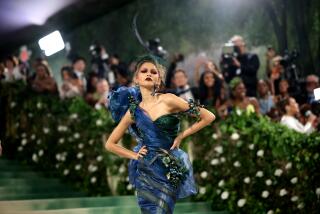Naughty photographer Helmut Newton gets his due at Annenberg Space, Los Angeles
Until 2011, the sexually charged photographs of Helmut Newton had never been the subject of a major U.S. museum show.
“It’s a hypocrisy of the American psyche,” says collector Manfred Heiting of the disparate reactions to Newton’s hugely influential work. Heiting, the late photographer’s friend and the organizer behind an exhibition that finally opened that year at the Museum of Fine Arts in Houston, adds, “Society has changed. We have changed.”
A version of that Houston show has now landed at the Annenberg Space for Photography in Los Angeles, drawn from Newton’s first three books — the career-defining “White Women,” “Sleepless Nights” and “Big Nudes.” Included are 125 new prints, some as large as 8-by-8 feet, showing in vivid black-and-white and color the German master’s gift for creating provocative scenes both passionate and cool.
Newton, who died at 83 in 2004, began as a fashion photographer who pushed the boundaries of desire and drama for adventurous editors at French Vogue, Italian Vogue and elsewhere, then pushed them further in his personal work. He challenged taboos and preferred his models tall and posed with precision and attitude, never meek.
“He made the women strong, and they loved him,” says Heiting, who lives in Malibu. “He was not a kinky guy. He positioned the women as they really wanted to see themselves, and that was a revelation.”
The pictures were also dependably controversial, showing models in handcuffs and corsets, poised on sharp stillettos or wearing monocles, in scenes sometimes inspired by Newton’s adolescent memories of Germany during the Weimar Republic. (He fled Nazi Germany in 1938.)
“If people found his work controversial, it was their problem,” says June Newton, the photographer’s widow, responding from her home in Monte Carlo to emailed questions. She was his close collaborator in all things and continues working to protect his legacy, now headquartered at the Helmut Newton Foundation in Berlin, though, she writes, “It was enough for him that his [own] generation saw his pictures.”
With this show, the Annenberg is venturing fully into adult territory not necessarily aimed at pleasant family consumption on a summer afternoon, adding a new layer to its repertoire following compelling shows of war photography, indigenous cultures and rock ‘n’ roll. The multimedia venue commissioned a new documentary, “Provocateur,” and will be regularly screening the hour-long “Helmut by June,” an intimate portrait by his wife that captures Newton at work in the last decade of his life and during his greatest fame.
“June’s role was almost like a partner to Helmut,” says David Fahey, co-owner of the Fahey/Klein Gallery on La Brea, which represented the photographer for many years. “She had great ideas. She designed all of his books. It was a perfect creative collaboration, the most successful I’ve seen.”
One of Newton’s most famous pictures documents the nature of their marriage and work together — a 1981 self-portrait by Newton capturing his own reflection in a mirror as he shoots a nude model, while June watches intently from beside the mirror.
“This show is a long time coming. It’s still pretty conservative in America, even within the art community,” says Fahey, who provided the Annenberg with his personal photographs of Newton and a videotaped interview from the 1980s. “Like all great artists, you remember his images. You can’t say that about everyone.”
“Helmut Newton: White Women / Sleepless Nights / Big Nudes,” through Sept. 8; Annenberg Space for Photography, 2000 Avenue of the Stars, Century City; free; open 11 a.m.-6 p.m. Wednesday through Friday, 11 a.m.-9 p.m. Saturday, 11 a.m.-6 p.m. Sunday; (213) 403-3000; annenbergspaceforphotography.org.
More to Read
The biggest entertainment stories
Get our big stories about Hollywood, film, television, music, arts, culture and more right in your inbox as soon as they publish.
You may occasionally receive promotional content from the Los Angeles Times.







